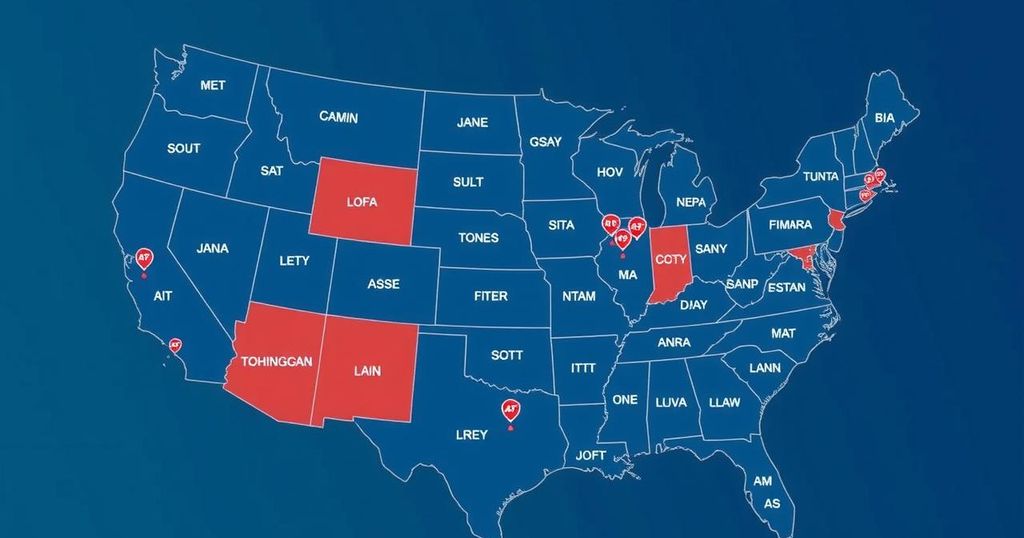World news
AFRICA, BIDEN, DEMOCRATIC NOMINATION, DEMOCRATIC PARTY, DEMOCRATS, ELECTION, HAMPTON ROADS, HOUSE, HOUSE OF REPRESENTATIVES, JEN KIGGANS, KO, KONDIK, NORTH AMERICA, NORTHERN VIRGINIA, PRESIDENTIAL ELECTION 2024, REPUBLICAN PARTY, SOUTH AFRICA, U. S. HOUSE OF REPRESENTATIVES, U.S. ELECTIONS, UNITED STATES, US ELECTIONS, VIRGINIA, VIRGINIA BEACH
Daniel O'Connor
0 Comments
Key House Races to Monitor on Election Night
The upcoming election night for the U.S. House of Representatives will be pivotal for both major parties. Democrats need only four more seats for a majority, while the current political climate allows for unprecedented outcomes—where Republicans could win the presidency while losing the House. Key races in Virginia, North Carolina, New York, and California are crucial indicators of voter trends, especially among African American and Hispanic demographics, as well as suburban and educated voters. The interplay of these races will shape not only House majority dynamics but also broader presidential election narratives.
As the impending presidential election looms, equally critical is the race for the U.S. House of Representatives, where Democrats aim to recapture control. The party needs to secure just four additional seats, giving them an approximately even chance to regain dominance in the chamber with a current total of 214 seats, including a few vacancies in solidly Democratic districts. Despite the traditional alignment of presidential and congressional outcomes, this year presents a possibility where Republicans could reclaim the presidency while potentially losing control of the House—a scenario unprecedented since the two-party system took shape. Historically, the results of House elections have begun aligning more closely with presidential outcomes in recent cycles. Therefore, specific House races may offer early indications of the election night narrative within the broader political landscape. One of the first states to close polls will be Virginia at 7 p.m., where competitiveness in House races can foreshadow outcomes. Notably, Virginia’s Second District, a military-centric area that supports Joe Biden by a slight margin, features incumbent Republican Jen Kiggans defending her seat. In contrast, Democrats are working to retain their foothold in the open Seventh District, which saw Biden outperforming his national margin in 2020. An unexpected flip in either district could indicate critical momentum for the respective party. Additionally, the shifting dynamics of voter support, particularly among African American demographics, is being scrutinized, especially in districts that Biden won in prior elections. North Carolina’s First District, held by Democrat Don Davis, stands out as a microcosm of issues facing the party. If Democrats face setbacks there, it could signify waning support among Black voters, hence reflecting on their broader electoral prospects. Conversely, a decisive win for Davis may suggest that Democratic challenges in this realm have been overstated. California and New York are also pivotal to House majority control, with several districts carried by Biden but currently represented by Republican incumbents. In New York’s 19th District, a tossup, the outcome will be critical; a win by Democrat Josh Riley against incumbent Marc Molinaro may signify a pathway for Democratic control of the House. Similarly, California’s 13th District, defended by first-term Republican John Duarte in a majority Biden-won area, represents another crucial battleground. Should Adam Gray, a Democrat, succeed in this district, it may bolster Democratic chances of a House majority. Another vital demographic to monitor is the Latino vote. California’s Hispanic-majority districts, including the 13th and the 22nd held by Republican David Valadao, could shape early perceptions of Democratic viability among Hispanic voters. The variability of this electorate across the country, notably in key districts like Pennsylvania’s Seventh—currently held by Democrat Susan Wild—will be critical for understanding the overall shifts in support. Concerning the presidential ballot, shifts among educated suburban voters are also notable, where Democratic trends have been pronounced. The outcomes in Maine’s Second District, a rural area that leans toward Trump, and Nebraska’s Second District, with more suburban and college-educated residents, will be worth tracking as they may not align with broader presidential trends. Engagement from the incumbents, Republican Don Bacon and Democrat Jared Golden, in these races will further elucidate voter inclinations in the Midwest, a politically sensitive region. Overall, the pathways to victory in House races mirror the electoral college landscape. The interplay of these challenges and victories reveals a dual narrative of the presidential race and the House majority contest as key congressional districts yield insights into nationwide demographic shifts and voter sentiments going into the election.
The article examines critical House races that will influence the dynamics of the upcoming presidential election. With Democrats aiming to regain control of the U.S. House of Representatives, key districts are highlighted to showcase how shifts in voter demographics and party alignments could impact the election outcomes on both the congressional and presidential levels. This analysis emphasizes strategic races in states like Virginia, North Carolina, New York, and California, as well as demographic trends that could alter the political landscape, particularly among African American and Hispanic voters as well as educated suburban demographics. Understanding these nuances is essential to grasp the complex electoral environment as the election night approaches.
In conclusion, the outcome of the upcoming election night will be significantly influenced by specific House races, which could provide crucial insights into broader voter sentiment and party strengths. As Democrats strive to reclaim a majority in the House, particular attention must be paid to races in Virginia, North Carolina, California, and New York, as these contests reflect shifting demographics and emerging electoral trends. The interconnectedness of the House races and presidential outcomes underscores the necessity of monitoring these developments closely as they could dictate the political landscape in the near future.
Original Source: www.nytimes.com




Post Comment